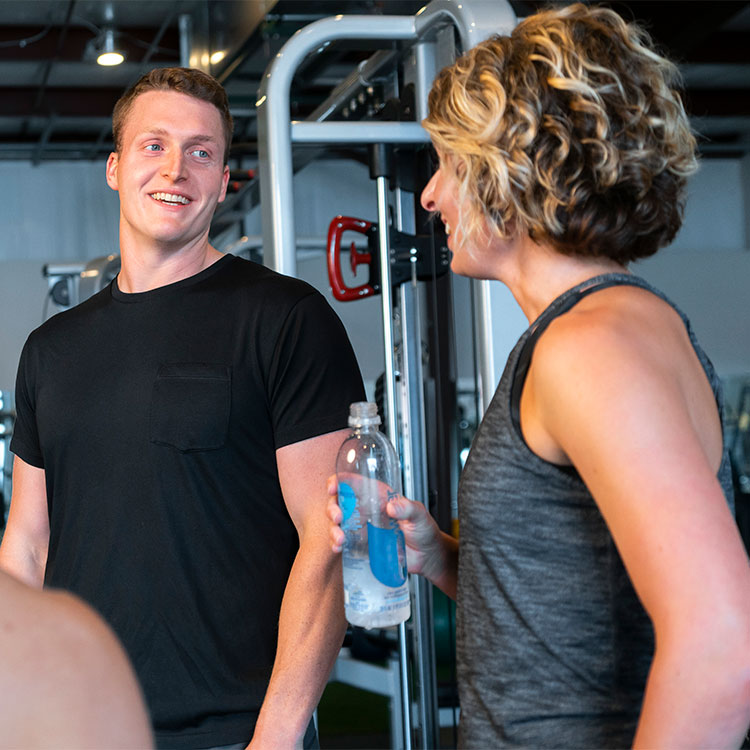Health & nutrition insights.
5 Components of a Well-Rounded Fitness Routine
We talk a lot about fitness and we love that it is one of the things in life that you can put the work in and improve the outcome. Movement can help you get stronger, healthier, and achieve your best physical life. We get a lot of questions about what is important when developing a fitness program. Just like healthy eating, having balance with types of movement is really important. To make sure you are getting all of the important components of fitness, we are going to discuss cardio, strength training, balance/core, mobility/flexibility, and rest. Including these 5 components of a balanced fitness program will help set you up for success!
Listen to our Practical Nutrition Podcast episode about this topic: https://spotifyanchor-web.app.link/e/ipqzItI0CAb
First Component: Cardio
Cardio is movement that increases your heart rate due to increased demands for oxygen to the working muscles. Your breathing is faster than normal, but not so fast that you can’t talk or that you are gasping for air. If you are curious about the recommended heart rate zones, getting a VO2 max test done is one of the best ways to see where your specific heart rate zones are. You can also estimate it based on the American Heart Association guidelines. Here is a link recommended cardio zones based on your age : https://www.heart.org/en/healthy-living/fitness/fitness-basics/target-heart-rates#:~:text=Your%20maximum%20heart%20rate%20is%20about%20220%20minus%20your%20age.&text=In%20the%20age%20category%20closest,70%2D85%25%20of%20maximum.
Movement is one of the healthiest things you can do for your body. Finding what you enjoy and learning to build them into habits can help you make fitness as part of your normal routine.
What are the benefits of cardio?
- Improves fitness level and ability to perform
- Improves blood lipids, blood pressure, and blood sugar control
- Increases blood flow
- Decreases risks for heart disease, stroke, diabetes, dementia, depression, anxiety, constipation, arthritis and cancer
- Improves mood, stress, balance, immune function, sleep, energy, body leanness, lung function, and sexual function
What are the recommendations?
- Anything will help, but ideally incorporating 150-300 min of cardio per week is the recommended amount. That is 30-60 minutes 5 days a week.
- If you think about it, there are 1,440 minutes every day, so this is only 2-4% of your day!
- Start small and remember, even if it is 5 minutes, it is worth it.
Second Component: Resistance/Strength Training
Using resistance (weight or gravity) to overload your muscles in a way that they break down and rebuild stronger qualifies as strength training. Building your strength is so important because as we get older, our muscle mass tends to decrease.
What are the benefits of strength training?
- Increases strength and ability to perform
- Improves blood sugar control and blood lipids
- Decreases risks for heart disease, stroke, diabetes, dementia, depression, anxiety, constipation, arthritis, and cancer
- Improves bone density, mood, stress, balance, immune function, sleep, energy, body leanness, insulin resistance, ability to stay independent as we gain more life experience
What are the recommendations?
- 2-3 days full body (or you can split to hit each body part 2-3 times per week)
- Low reps or high reps work great-you want to challenge your muscles in a way that is hard
- Weights, bands, body weight, machines, and cables are just a few of the ways you can incorporate resistance training.
- Be sure you are giving your muscles 48 hours to recover between strength training sessions
Third Component: Balance and Stability
Training the muscles that work to balance and stabilize your body by adding unstable surfaces, visual changes, adding resistance, unilateral movements, and core work all will help your balance and stability.
What are the benefits of balance and stability training?
- Helps prevent injuries and improves body mechanics
- Decreases fall risk
What are the recommendations?
- Unlike other strength training, you can train balance and stability every day or even multiple times a day
- Consistency helps with improvement
- Bosu or foam pads, closing eyes, bands, anti-rotational exercises, standing core exercises, one leg exercises, stability ball
Fourth Component: Mobility and Flexibility
Working on your range of motion and ability for muscles to lengthen helps with mobility and flexibility.
What are the benefits of mobility and flexibility work training?
- Likely helps prevent injuries and improves body mechanics
- Improves ability to exercise safely and effectively
What are the recommendations?
- Unlike other strength training, you can train mobility and flexibility every day or even multiple times a day
- Consistency helps with improvement
- Foam roll, static stretching, dynamic stretching, yoga
Fifth Component: Recovery and Rest
Taking time off from exercise or taking some time that is lower intensity to recover from harder workouts, along with getting adequate sleep is really important for overall health. What are the benefits of rest and recovery?
- Decreases injury and illness risk
- Lowers stress on the body
- Rebuild stronger and better
- Enhances ability to perform
What are the recommendations?
- 7-9 hours of sleep every night
- General rule of alternating 1 hard day/1 easier day for high intensity cardio like running (hard= faster, longer, more resistance; easier = shorter, slower, less resistance)
- Muscles need 48 hours to recover, so don’t train the same muscle group within 48 hours.
- Recovery day can mean low impact movement
So in summary, getting all of the components of a well rounded fitness program can help you have great results! If you are unsure of where to start or if it is safe to start, be sure to talk to an exercise professional for guidance. Here are some tips:
- Start slow-assess where you are so you don’t overdo it
- There is never a good time to start, so you may as well go for it
- Focus on how movement makes you feel
- Anything is better than nothing
- Consistency can really help

